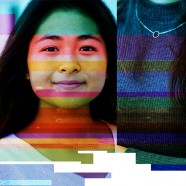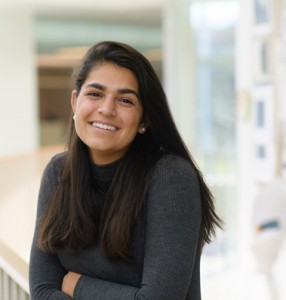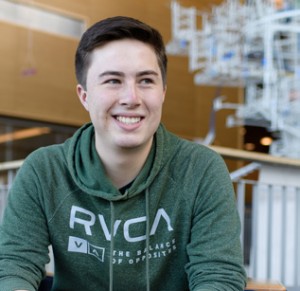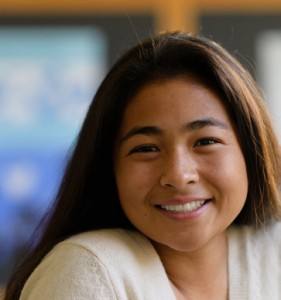
What happens when you take your energy and your passion as far as you can? Many teenagers are driven by a talent or a recently discovered fascination, to pursue new exposure, and follow any lead that opens up.
Gabrielle Fernandopulle, Alex Iansiti, and Elina Thadhani, all Class I, are three such adventurers. Rooted in Milton life, they have at the same time sought and seized every opportunity to expand and test the intrigue they feel for math, programming and science. Their personal passions emerged when they were very young, and each has been bent on keeping up a certain level of excitement, getting into worlds beyond where they’ve been.
Alex says that when he was young, he took apart every motorized toy that came his way. He took out the screws, manipulated each part, and asked his dad which thing did what and why. He loved computer games, and then computers in general. As a fifth grader, he jumped into Visual Basic for Dummies. From sixth grade through ninth, he transitioned from learning the basics of Java to going off on his own, diving into projects—making games in Java, building websites, creating apps—and coming back with his questions or ideas to a tutor.
Gabrielle remembers loving stories, and the thrill of achievement she felt each time she finished a book. Logic puzzles, books of them, held a special place in her heart, especially arguing about the approaches and the answers. To amp up the math curriculum for Gabrielle, her elementary school gave her challenge problems and “I learned how to think about math problems there,” she says. In middle school, she was a fan of LEGO robotics, and the LEGO League competitions, where the task was programming the robot to complete an obstacle course autonomously. “I liked the building/engineering part, but what I really loved was the logic part, finding the smartest and most reliable approach to programming the robot to do something repeatedly and accurately.” She built and programmed underwater gliders at a summer camp before starting at Milton.
Elina reports happily that she “was born into a science-heavy, inquiry-heavy family.” They’d watch National Geographic and Planet Earth together. More important, her parents (her dad, especially) would come to the family dinner table with a relevant and absorbing science problem. Drawn from current events or new research or someone’s bold idea, “he would present the anomalies in the scientific community, and we’d spend most of dinner trying to figure them out,” Elina says. She remembers one night trying to figure out how to get a predatory shrimp together with the kind of snail that harbored a disease-bearing parasite. The family came up with the idea of creating a dam system that would keep the shrimp from exiting the waters where the snail was. “I was already thinking through the scientific process then,” she says. “It wasn’t a burden or tricky; it was exciting and fun.” She and her dad had a math routine, too. When she showed up each morning, he’d hand off a math problem. “If I finished in ten minutes,” she laughs, “I could have breakfast. And I came to freshman year with math as my passion.”
Alex came to Milton primed to push his programming experience as far as he could go. Milton’s curriculum in this field has evolved alongside Alex’s growth over his four years. He’s been both a participant and a contributor. “I’ve loved the new electives,” Alex says, “but advanced programming, my first course, was still my favorite.”
The course was about how the different algorithms work and their relative efficiency, Alex summarizes. “It was probably the format of the course that worked so well,” he says, “a structured curriculum to teach the concepts, paired with independence. For instance, an assignment would be to create a game showing a particular concept. Our final project was to create an MP3 player, and that involved circuitry, which I loved.”
TESTING THE MATH SIDE OF PROGRAMMING
Alex loves what he calls “both sides of programming.” The “math side” requires thinking about a problem abstractly, proposing a number of solutions, and choosing the best one. The “app side,” he explains, has all of the math, plus the design side (the look and feel, as well as making it work), and that allows him to explore the artistic side of computing.
After one summer interning at a commercial start-up that called on the “app-y use side of programming,” Alex wanted to spend last summer working in hard computer science, on the “math-y” end of programming. That he did, with a lab at Harvard’s School of Engineering and Applied Science that was working on writing software meant to facilitate millimeter wave internet—that is, processing that uses super-high-frequency radio waves. “There are some hurdles to get over on the way,” Alex says, “to creating software that achieves that goal.”
Last June, with a linear algebra textbook under his arm, Alex plunged into math and programming research, “outside my comfort zone.” He completed several crucial “proof of concept” tests that fed into the lab’s major project. He worked in digital signal processing, implementing a basic angle-of-arrival algorithm—testing whether millimeter waves between a router and a phone could pretty accurately target where in the room the phone was. “Since the main portion of the lab’s paper will be on how to improve on that algorithm, I was pretty happy with how far I got on that.”
Alex has been able to share what he learned in the lab about machine learning, “a subset of artificial intelligence,” with his classmates (eight of them) in the Artificial Intelligence and Applied Math course back at Milton. Alex’s graduate student mentor from the summer comes to Milton as well; about every third week, he assists kids who want hands-on experience with this rapidly expanding area of programming.
Gabrielle is one of Alex’s classmates in the course. Fixated on math when she arrived at Milton, she took an aggressive pathway through the math curriculum, but missing the fun of her LEGO competitions, she took the first-level programming course as a sophomore.
“It’s great,” Gabrielle says, “that programming is integrated into every Geometry class now. That’s a good idea. But I walked into programming having no idea what to expect. It’s a testament to Milton’s curriculum, and the attitude about learning that Mr. Hales and Mr. Chun have built, that I loved it so much. It’s very different from my other classes; it’s process-based.” The environment her teachers have created, she says, encourages students to “dream big and be okay with messing up. They pushed me to have fun with it.”
ONE GIRL, CODING
Girls Who Code, a national nonprofit dedicated to closing the gender gap in technology, was another big influence on Gabrielle. Girls Who Code shows girls how varied coding is, and how important it is to anything you like to do. Girls create games to explain political issues, or they produce music, or design sports or fashion websites; Girls Who Code tries to reframe the stereotypical sense of coding and helps girls imagine a future in tech.
Numbers of girls in programming at Milton have steadily increased. Gabrielle and several other girls led the way, and she’s clear about the cultural trends that have affected girls. “Our culture has taught girls to be more fearful of failure,” she says. “I saw that in the intro course, where boys would just laugh failure off and start up again. And there’s the male-dominant voice, too, and girls not wanting to talk over other people.” But the balance is shifting, according to Gabrielle. “Younger girls are signing up for courses and sticking with it. They’re finding out that even though boys grew up with video games, they don’t have an advantage. And the projects are free-form: You don’t have to build a shooting gallery. You can build a lacrosse simulation game or a shopping app.”
Gabrielle’s summer internship was with an early-stage data procurement and analysis software company, Tamr. The company developed software for major companies (like GE and Cisco) to reformat all of the disparate data sets that are crucial to business and organize them to increase access and functionality. Their clients save money through improved efficiency. Gabrielle was a member of the “labs section” of their development team; her group took on special projects. Her role was taking data sets in different languages (like German and Japanese), using dictionaries the company had access to, and translating the data, cleaning it up, analyzing and reformatting it so the information could be used efficiently and effectively.
“This was really a time and place where I could just dive in,” says Gabrielle, “because what they were doing was so far above what I had done before.” She downloaded the company’s source code—thousands of Java files—and then “spent most days of the first week Googling things.” Experiencing the design and complexity of commercialized software was revealing, she says. She found her colleagues kind and supportive. She had no fear of asking questions and often did so using Slack, a messaging app for teams. She loved the environment of the tech world she saw. “I appreciated how meritocratic it was. Hard work is rewarded, regardless of seniority.” The company managed work through small teams; in stand-up meetings they shared aspects of product development, and the shared information often tweaked the way the teams worked. She was shocked by how collaborative programming could be, and by how much her colleagues enjoyed the teaching role that came with welcoming interns.
Gabrielle is thinking now that she may want to major in computer science. She loves the power and the problem solving, as well as its relevance to so many fields that interest her. Females are underrepresented, she notes, and “the communication and teamwork that programmers need is a big part of who I am.”
HELPING PREDICT A GLACIER’S RETREAT
Both Gabrielle and Elina created a major communication opportunity for themselves, when their abstract about the findings of a four-year research project on sea ice was accepted for presentation at the American Geophysical Union’s annual meeting in San Francisco this past December. In their Class IV year, both girls signed up for a student outreach group associated with faculty member Matt Bingham’s National Science Foundation grant to study sea ice in Disko Bay, Greenland, at the mouth of the Jakobshavn Glacier.
With colleagues from Wheaton College and Brown University, Matt Bingham was studying sea ice variability, because high sea ice has been associated with slowing the retreat of the glacier. To make predictions about the rate of glacial retreat and rising seas, scientists need data about the variability of sea ice prior to the evaluations of the last several decades, which were done through satellite imagery. Mr. Bingham brought a two-meter ice core back from Greenland, and students have been mirroring the scientific team’s investigations. Elina and Gabrielle tried to determine whether methanesulfonate (MSA) could be used as a valid proxy to generate records of sea ice variability deep into the past, and therefore to help predict how glaciers will retreat. In their two-meter core, they did find a correlation between parallel peaks in MSA, oxygen isotope and low sea ice, indicating the potential of MSA as a proxy for sea ice concentration, and the girls will present the findings at a conference poster session. They’re not only excited “to be presenting our four years of hard work at such a huge conference,” says Gabrielle, “but also to connect with the principal investigators we’ve been working with and hear about their work.”
DESIGNING TESTS TO ANSWER QUESTIONS THAT MATTER
The San Francisco conference was Elina’s third presentation at a national professional science conference this year. Elina has never met an uninspiring scientific question, it seems, and her Advanced Chemistry course at Milton served as a launching pad for two research projects she pursued in the Pritzker Science Center, on campus.
In one project, Elina examined an idea for improving the treatment of glycine encephalopathy, a rare autosomal recessive disorder characterized by high cerebrospinal fluid and plasma glycine concentrations. She presented a poster of her findings, titled “Glycine’s affinity to a cation-exchange resin offers potential treatment for glycine encephalopathy,” at the American Association for Clinical Chemistry 2016 Meeting in Philadelphia.
In a second project, she focused on issues having to do with recovery after a myocardial infarction (heart attack). Elina was invited to present her conclusion, abstracted as the “Fabrication of a conductive, drug-delivering alginate hydrogel through cerium IV crosslinking offers base as a synthetic heart tissue,” at the Biofabrication 2016 Conference, in Winston-Salem, North Carolina.
As was the case with Alex and Gabrielle, summer work fired up Elina’s excitement and skills, her sense of independence and responsibility. Course work at Milton kept the flames high and opened up other doors.
Elina says that she wanted to know “how research happens in a real scientific community, and how I might do something that could lead to an innovation.” Even though she’s spent long hours in labs during the summers, Elina says she was “driven by the idea that I had a role, that I made a difference in ongoing research. She worked at MIT in Bevin Engleward’s biological engineering lab on DNA damage, and the effect of carcinogens. Like Alex, she was thrilled to have demonstrated proof of concept for her hypothesis.
“What I love is that a science question is not only a puzzle, it’s a very precise puzzle. Just designing an experiment is an art in itself. Are the conditions optimal? Is the theory behind my experiment working? Where does my theory have holes? What kind of controls are correct? Is my precision spot on?”
Elina has worked on projects individually, with the support of Milton faculty, and she has worked collaboratively; she enjoys both modes. She tends to think of everything as an intricate machine, and finds it endlessly interesting to learn about every part, from the intra-cellular level to the whole organ system. Why are we the way we are? Evolutionarily, how do the cellular components work together?
Science is amazing because you’re never done, according to Elina. There’s always something deeper, something further. She fondly remembers her grandfather’s musing: “Every time you come across a success, you come across ten new possibilities for success, but 100 new possibilities for failure.” So you have to pursue each one with vigor, Elina believes.
by Cathleen Everett






